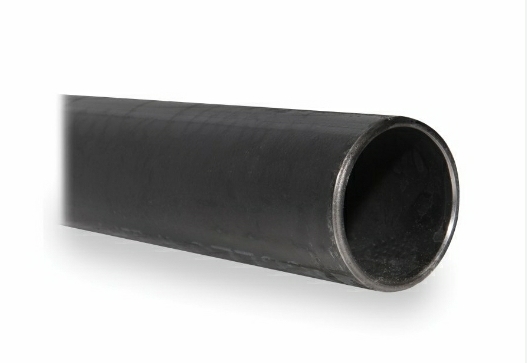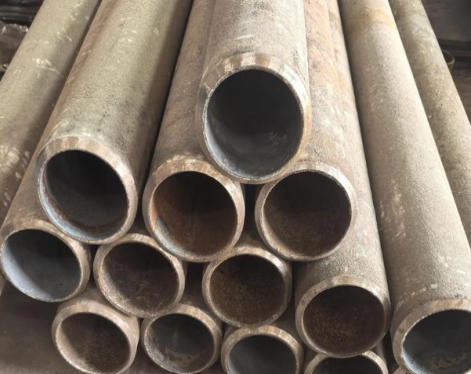1.What is ASTM A53 pipe?
ASTM A53 is a carbon steel alloy, used as structural steel or for low-pressure plumbing. The alloy specifications are set by ASTM International, in specification ASTM A53/A53M.A53 pipe comes in three types and two grades, A53 Type F, which is longitudinally furnace butt welded or continuous welded (Grades A and B), A53 Type E, which is longitudinally electric resistance welded (Grades A and B), and A53 Type S, which is seamless pipe, produced by hot working, and possibly cold finishing, the steel (Grades A and B).
2.What is ASTM A53 black steel pipe?
ASTM A53 black steel pipe, also referred to as ASME SA53 pipe, is an excellent candidate for most processing. Featuring a semi-smooth surface coated with black lacquer. Black steel pipe is intended for mechanical and pressure application. Common applications include steam, water, air, and gas systems. ASTM A53 is the standards specification covers seamless and welded, black and hot-dipped galvanized nominal (average) wall pipe for coiling, bending, flanging and other special purposes and is suitable for welding.A53 bare steel pipe sizes are specified by two non-dimensional numbers. Nominal pipe size (NPS) or inside diameter (ID), and pipe schedule (SCH) referring to the wall thickness.
3.Features and applications of ASTM A53 black steel pipe
The ASTM A53 specification for black steel pipe outlines its characteristics and common applications. Here are some features and applications of ASTM A53 black steel pipe:
(1)Features:
Material:ASTM A53 black steel pipe is made from carbon steel, which provides durability and strength.
Coating: It is non-galvanized and typically has a black coating to prevent rust and corrosion.
Weldability: Suitable for welding, threading, and grooving, making it versatile for various installation methods.
Dimensions: Available in various sizes and thicknesses to suit different industrial and construction requirements.
(2)Applications:
Water Transmission: Used for gas transmission and distribution in various industries and municipal applications.
Structural Purposes: Commonly employed for structural support in construction and infrastructure projects.
Mechanical Components: Utilized in the fabrication of mechanical components such as handrails, fences, and scaffolding.
Oil and Gas Industry: Widely used in the oil and gas industry for conveying fluids and gases in pipelines.

4.Hot dipped galvanized ASTM A53 black steel pipe
Steps for hot-dip galvanizing treatment of ASTM A53 pipe
ASTM A53 pipe → degreasing → water washing → pickling → water washing → dipping in plating solvent → drying and preheating → hot dip galvanizing → finishing → cooling → passivation → rinsing → drying → inspection.
Reasons why ASTM A53 pipe is hot-dip galvanized
(1)Low processing cost
The cost of hot-dip galvanizing for rust prevention is lower than that of other paint coatings;
(2)Durable
In suburban environments, the standard hot-dip galvanized anti-rust layer can last for more than 50 years without repairs; in urban or offshore areas, the standard hot-dip galvanized anti-rust layer can last for 20 years without repairs. ;
(3)Good reliability
The galvanized layer and the steel are metallurgically bonded and become part of the steel surface, so the durability of the coating is relatively reliable;
(4)The coating has strong toughness
The galvanized layer forms a metallurgical structure that can withstand mechanical damage during transportation and use;
(5)Comprehensive protection
Every part of the plated parts can be plated with zinc, even in depressions, sharp corners and hidden places, they can be fully protected;
(6)Save time and effort
The galvanizing process is faster than other coating construction methods, and can avoid the time required for painting on the construction site after installation.
(7)Low initial cost
Generally speaking, the cost of hot-dip galvanizing is lower than that of applying other protective coatings. The reason is simple. Other protective coatings such as sanding and painting are labor-intensive processes. On the contrary, the process of hot-dip galvanizing is higher. Mechanized, tightly controlled in-plant construction.
(8)Inspection is simple and convenient
The hot-dip galvanized layer can be tested visually and with a simple non-destructive coating thickness meter.
ASTM A53 is a carbon steel alloy, used as structural steel or for low-pressure plumbing. The alloy specifications are set by ASTM International, in specification ASTM A53/A53M.A53 pipe comes in three types and two grades, A53 Type F, which is longitudinally furnace butt welded or continuous welded (Grades A and B), A53 Type E, which is longitudinally electric resistance welded (Grades A and B), and A53 Type S, which is seamless pipe, produced by hot working, and possibly cold finishing, the steel (Grades A and B).
2.What is ASTM A53 black steel pipe?
ASTM A53 black steel pipe, also referred to as ASME SA53 pipe, is an excellent candidate for most processing. Featuring a semi-smooth surface coated with black lacquer. Black steel pipe is intended for mechanical and pressure application. Common applications include steam, water, air, and gas systems. ASTM A53 is the standards specification covers seamless and welded, black and hot-dipped galvanized nominal (average) wall pipe for coiling, bending, flanging and other special purposes and is suitable for welding.A53 bare steel pipe sizes are specified by two non-dimensional numbers. Nominal pipe size (NPS) or inside diameter (ID), and pipe schedule (SCH) referring to the wall thickness.
3.Features and applications of ASTM A53 black steel pipe
The ASTM A53 specification for black steel pipe outlines its characteristics and common applications. Here are some features and applications of ASTM A53 black steel pipe:
(1)Features:
Material:ASTM A53 black steel pipe is made from carbon steel, which provides durability and strength.
Coating: It is non-galvanized and typically has a black coating to prevent rust and corrosion.
Weldability: Suitable for welding, threading, and grooving, making it versatile for various installation methods.
Dimensions: Available in various sizes and thicknesses to suit different industrial and construction requirements.
(2)Applications:
Water Transmission: Used for gas transmission and distribution in various industries and municipal applications.
Structural Purposes: Commonly employed for structural support in construction and infrastructure projects.
Mechanical Components: Utilized in the fabrication of mechanical components such as handrails, fences, and scaffolding.
Oil and Gas Industry: Widely used in the oil and gas industry for conveying fluids and gases in pipelines.

4.Hot dipped galvanized ASTM A53 black steel pipe
Steps for hot-dip galvanizing treatment of ASTM A53 pipe
ASTM A53 pipe → degreasing → water washing → pickling → water washing → dipping in plating solvent → drying and preheating → hot dip galvanizing → finishing → cooling → passivation → rinsing → drying → inspection.
Reasons why ASTM A53 pipe is hot-dip galvanized
(1)Low processing cost
The cost of hot-dip galvanizing for rust prevention is lower than that of other paint coatings;
(2)Durable
In suburban environments, the standard hot-dip galvanized anti-rust layer can last for more than 50 years without repairs; in urban or offshore areas, the standard hot-dip galvanized anti-rust layer can last for 20 years without repairs. ;
(3)Good reliability
The galvanized layer and the steel are metallurgically bonded and become part of the steel surface, so the durability of the coating is relatively reliable;
(4)The coating has strong toughness
The galvanized layer forms a metallurgical structure that can withstand mechanical damage during transportation and use;
(5)Comprehensive protection
Every part of the plated parts can be plated with zinc, even in depressions, sharp corners and hidden places, they can be fully protected;
(6)Save time and effort
The galvanizing process is faster than other coating construction methods, and can avoid the time required for painting on the construction site after installation.
(7)Low initial cost
Generally speaking, the cost of hot-dip galvanizing is lower than that of applying other protective coatings. The reason is simple. Other protective coatings such as sanding and painting are labor-intensive processes. On the contrary, the process of hot-dip galvanizing is higher. Mechanized, tightly controlled in-plant construction.
(8)Inspection is simple and convenient
The hot-dip galvanized layer can be tested visually and with a simple non-destructive coating thickness meter.
Previous:Use of Z type sheet pile









